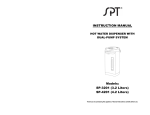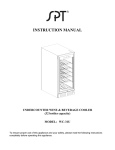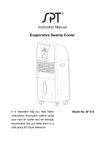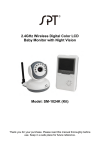Download Please read OPERATING instructions carefully for correct operation
Transcript
Please read OPERATING instructions carefully for correct operation Identification of Parts and Correct Methods of Operation. 1. Top Plate Do not place unstable or heated/hot objects on top. 2. Freezer Chamber Chamber for freezing food, storing frozen food and making small quantity of ice. 3. Ice Tray Tray for making ice cubes. Fill tray with cool boiled water to 4/5 volume, place evenly on bottom of freezer chamber. To make ice cubes quickly, set the temperature regulator knob to a higher setting (refer to 5). To remove ice cubes from the tray, wrench gently – do not bend with force. 4. Cold-Storing Chamber Chamber for cold storing food and beverage. At the bottom is a drawer for storing fresh vegetable and fruit. 5. Temperature Regulator Regulates the temperature of the refrigerator. From position “1” to “7”, Correct Positioning For purpose of safety, reliance, low power consumption and durability of your fridge, please pay close attention to the followings. Well Ventilation Good ventilation is needed around the fridge for easy dissipation of heat, higher efficiency of refrigeration and low power consumption. For this purpose, sufficient clear space should be kept around the unit. The back should have at least 100mm of space from the wall, the sides with 200mm and the top with 300mm. Room should be left to allow the door to open to 160. Power Line Cord Do not lengthen or fold the cord into coil during operation. More importantly, keep cord away from the compressor during operation. The heat from the compressor may deactivate the insulation or cause leakage of electricity. Power Supply The fridge is only applied with single-phase power supply with alternating current of 115V, 60Hz. If fluctuation of voltage exceeds the above, for safety sake, apply A.C. automatic voltage regulator of more than 350W. The unit must employ a special power socket instead of the common one with other appliances. THE PLUG MUST MATCH THE SOCKED WITH GROUND WIRE. Protection from Moisture Avoid placing the fridge in a place with heavy moisture to minimize possibility of rust to its metal components. Do not spray water directly on the fridge or poor insulation and current leakage would occur. Even Placement The ground for refrigerator placement must be flat and solid. Do not place on soft material such as foam, plastic, etc. If fridge does not sit on the same level, adjust the legs accordingly. Do not place unit near anything that echo. Protection from Heat Refrigeration should be placed away from any heat source or direct sunshine. Keep Away from Danger It is inadvisable to place the fridge near any combustibles such as gas, petrol, alcohol, lacquer, banana oil, etc. The above mentioned object should also not be stored within the fridge. Moving When transporting the unit, do not turn the unit upside-down, set unit horizontally or with more than a 45 tilt. Beginning of Operation After the fridge has been placed in position, wait for 5 minutes before plugging in the unit. Do not store anything until the temperature inside has become low enough. Cautions Power Failure After electricity failure, wait for at least 5 minutes before turning on the refrigerator again or you may damage the compressor. If you get a notice about power failure beforehand, set the temperature regulator to the strongest setting (position “7”) 2 ~ 3 hours before power is cut. Make as much ice cubes as possible and place in the cold storage chamber right before power is out. Limit opening the doors in order to keep the inside temperature low. If the outage is quite long, check whether there is water from dissolved frost or ice at the bottom of freezer before you re-operate the unit. If so, be sure to wipe dry with a soft cloth, to prevent the water turning into ice on the sides of the chamber. Storing and Taking out food It is not advisable to load the fridge too full or too compact as it will prevent air circulation within and waste energy. It is recommended to wrap food or place in containers before you store in fridge. This will prevent the food from drying up and inter-filtration of tastes among different kinds of food. For washable food, wash and wipe dry before storing in chamber. Certain foods, such as pumpkin, radish, onion, banana, etc. need not be stored in fridge. Close doors immediately after storing or taking out food. Otherwise, the temperature inside may rise and increase power consumption. Gas Leakage If there is a gas leakage, do not touch the unit until the gas valve is turned off and the air in the room is exchanged. If you pull the power plug or turn the temperature regulator immediately, sparks may occur. REMEMBER, DO NOT TOUCH THE FRIDGE UNDER THIS CIRCUMSTANCE. Defrosting Why Defrosting Water contained in goods or in the air may form a layer of frost inside. It will weaken the refrigeration when the frost is thick. Once the frost is 10mm thick, please defrost. Defrosting in Cold-Storing Chamber Switching the temperature regulator on or off automatically controls defrosting, so there is no need of manual defrost. Water from defrosting will be drained into a water-container through a drainpipe at the lower-back of the unit and evaporated automatically. Defrosting in Freezer Chamber Defrosting in the freezer chamber is operated manually. Before defrosting, remove inside contents and ice tray, or place in cold-storing chamber temporarily. Set the temperature regulator to position “0” and leave the freezer door open until ice and frost dissolve completely. Wipe off water with soft cloth. To speed up the process, place a bowl of warm water (about 50C) in the chamber and gently scrape the ice with a spatula. After defrosting, replace contents and set temperature back to original setting. DO NOT heat the freezer chamber directly with hot water or heat (i.e. hair dryer) while defrosting to prevent deformation of the inner case. It is also inadvisable to scrape off the ice or separate food stuck to the chamber with sharp tools or wooden bars, this will damage the inner casing or the surface of the evaporator. Cleaning and Maintaining Fridge should be cleaned and maintained once every town months. Before doing so, unplug the power cord. Cleaning Method Wipe the inner and outer surface with damp cloth. If very dirty, scrub gently with mild detergent, clean with water and wipe dry. At the end it is recommended to use a small quantity of glass wax to polish the outside surface. Cautions For cleaning, do not use hot water, diluents, petrol, alcohol, kerosene, washing powder, cleanser, alkaline detergent, acid, or other harsh chemicals, which may damage the lacquer coating and plastics. Do not spray water directly onto fridge, causing rust and weaken insulation. Be sure to always keep the rubber seals on the doors clean. If plastics parts in the chambers remain contaminated by oil for a long period of time, it will easily age and possibly crack. Not Operating Temporarily If you plan not to use the fridge for some time, please unplug the power cord and remove all contents from chambers. Clean and store unit in a cool, dry place and leave doors ajar. Diagnosis and Trouble Shooting Please read the following carefully, the following are not defects: When compressor is operating, the normal surface temperature is between 80~90C. There are heat pipes stored inside the unit to prevent “sweating” on the outer surface, which becomes a little warm. There is a condenser used to dissipate heat, inside both of the inner-storing side plates, so they are slight warm. After starting or stopping of the compressor, a “ping-peng” sound may be heard. This is due to the evaporator in the cold-storing chamber is defrosting and water on the surface is being condensed. Sometimes you may hear sounds of running or boiling water, this results from the flowing of refrigerant. When relative humidity is quite high, condensation would take place on the unit’s surface. This is natural, please wipe off with dry cloth, or move fridge to a place with good ventilation. While the temperature regulator is set to any of the ON position and the compressor sops operating, there may still be a small reading on the kilowatt-hour meter. This means defrosting is underway and consuming very small amount of power. Not Refrigerating at All Is the power cord loose from the outlet or not connected? Has the power circuit fused? Any trouble or wrong connection with the circuit? Is voltage correct? (198~242V) Has the temperature regulator been set to position “0”? Poor Refrigeration Is the temperature regulator set properly? Is food or contents piled too thick? Any hot food placed in the fridge? Were the doors opened too frequently or not shut completely? Is the fridge in a suitable place? Loud Noise Is the floor solid or flat? Is the fridge seated stably? Is the fridge touching the wall or other object? Frozen Food in Cold-Storing Chamber Is the temperature regulator set too high? Or set to position “7” for a long period of time? Is there water-rich food in the chamber? Is the ambient temperature too low? (less than 10C) Never Stops Working Is the temperature regulator set too high? (positions “6” & “7”) Is there too much food in the chamber at one time or any hot food? If so, the compressor will not return to normal until it operates for several hours. Has the doors been opened too frequently or not shut properly? Is the ambient temperature too high? After checking, if troubles still persist, contact the manufacture. Do not disassemble any parts by yourself or you may void the warranty. REFRIGERATOR Your Guarantee If this product is found to be faulty as a result of faulty materials or workmanship within one year from date of purchase, it will be repaired or replaced free of charge. This guarantee is subject to the following terms: Sunpentown, must be notified of the fault. Proof of purchase must be presented to Sunpentown’s nominated representative. The warranty will be void if the product is modified, modified, misused or repaired by an unauthorized person. The guarantee after repair or replacement will not be extended beyond the original one year period. All replacement parts or units will be new or reconditioned. Parts or units, which are replaced, become the property of Sunpentown. The warranty applied for the use of the product in the USA. Warranty does not include freight charges. Sunpentown International Inc. 18249 Valley Blvd. City of Industry, CA 91744 Note: For Service, please call: 1-800-330-0388 or visit www.sunpentown.com This GUARANTEE is in addition to your Statutory Rights. Dear Customer: Please keep this warranty for your record. DO NOT return it



















